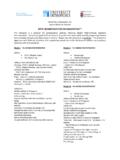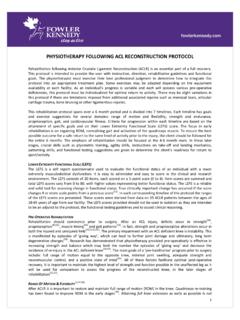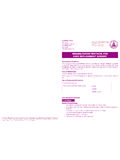Transcription of Lateral Retinacular Release Rehab Protocol - SASPINE
1 rehabilitation Protocol AFTER Lateral Retinacular RELEASER ehabilitation Progression The following is a general guideline for the progression of the rehabilitation pro-gram following Lateral Release . Progression through each phase should take into consideration patient status (eg. healing, function) and physician advisement. Please consult the physician if there is uncertainty regarding the advancement of a patient to the next phase of rehabilitation . PHASE I Begins immediately following surgery and lasts approximately 1-2 weeks.
2 Goals: -protect healing soft tissue structures -improve knee range of motion -increase lower extremity strength including quadriceps muscle re-education -education of patient regarding limitations and rehabilitation process Weightbearing Status: -Weightbearing as tolerated with 2 crutches Therapeutic Exercise: -Quad sets and isometric adduction with biofeedback for VMO -Heel slidesOrthopaedic and Spine Institute21 Spurs Lane, Suite 245, San Antonio, TX Tel# 210-487-7463 -Ankle Pumps-Non - weightbearing gastroc/soleus, hamstring stretches-SLR in flexion with turnout, adduction, and extension.
3 Begin hip abduc-tion at approximately 3 weeks-Functional electrical stimulation may be used-Begin aquatics if available at 2 weeks with emphasis on normalization of gait-Stationary bike for ROM when patient has sufficient knee flexion PHASE II Begins 1-2 weeks post-op and extends to approximately 4 weeks post-op Criteria to advance to Phase II: -Good quad set -Approximately 90o active knee flexion -Full active knee extension -No signs of active inflammation Goals: -Increase flexion ROM -Increase lower extremity strength and flexibility -Restore normal gait -Improve balance and proprioception Weightbearing status: May begin ambulation WBAT without crutches if the following criteria are met.
4 -No extension lag with SLR -Full active knee extension -Knee flexion of 90-100o-Non-antalgic gait pattern (may ambulate with one crutch or a cane to normalize gait before ambulating without assistive device) Orthopaedic and Spine Institute21 Spurs Lane, Suite 245, San Antonio, TX Tel# 210-487-7463 Therapeutic Exercise: -Wall slides from 0-45o knee flexion, progressing to mini-squats -4 way hip for flexion, extension, and adduction -Closed chain kinetic terminal knee extension with resistive tubing or weight machine -Calf raises -Balance and proprioceptive activities -Treadmill walking with emphasis on normalization of gait pattern -ITB and hip flexor stretchingPHASE III Begins approximately 4 weeks post-op and extends through approxi-mately 8 weeks post-opCriteria for advancement to PHASE III.
5 -Normal gait -Good to normal quadriceps strength-Good dynamic control with no evidence of patellar maltracking or instability-clearance by physician to begin more concentrated closed kinetic chain program Goals: -Restore any residual loss of ROM -Continue improvement of quadriceps strength -Improve functional strength and proprioception Therapeutic Exercise: -Quadriceps stretching when full knee flexion has been achieved -Hamstring curl -Leg press from 0-45o knee flexion -Closed kinetic chain progressionOrthopaedic and Spine Institute21 Spurs Lane, Suite 245, San Antonio.
6 TX Tel# 210-487-7463 -Abduction on 4-way hip -Stairmaster -Nordic Trac -Jogging in pool with wet vest or belt PHASE IV Begins approximately 8 weeks post-op and extends until patient has re-turned to work or desired activity. Criteria for advancement to PHASE IV - Release by physician to resume full activity -No patellofemoral or soft tissue complaints -No evidence of patellar instability -Necessary joint range of motion, muscle strength, and endurance Goals: -Continue improvements in quadriceps strength -Improve functional strength and proprioception -Return to appropriate activity level Therapeutic Exercise.
7 Functional progression which may include but is not limited to: -Slide Board -Walk/jog progression -Forward and backward running, cutting, Figure 8 -Plyometrics -Sport-specific drills -Work-hardening programOrthopaedic and Spine Institute21 Spurs Lane, Suite 245, San Antonio, TX Tel# 210-487-7463




